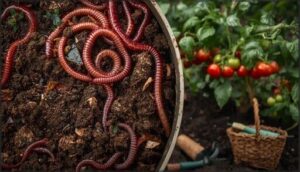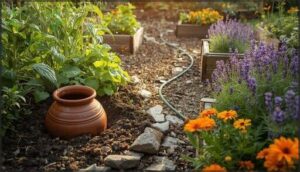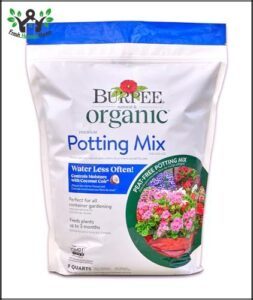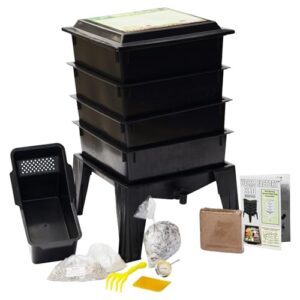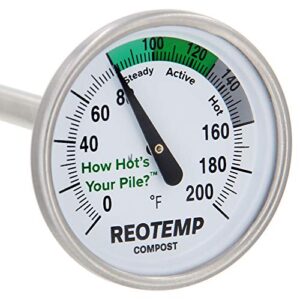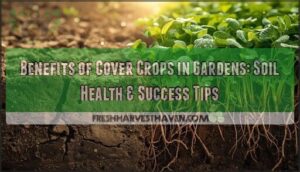This site is supported by our readers. We may earn a commission, at no cost to you, if you purchase through links.
Most gardeners don’t realize their soil is dying—even when their tomatoes look great. Conventional gardening methods deplete nutrients faster than they’re replaced, leaving behind compacted earth that depends on synthetic fertilizers to produce anything at all.
That’s where regenerative agriculture practices for home gardens flip the script. Instead of extracting from your soil year after year, you build it into something richer, more alive, and more productive than what you started with.
The best part? You’ll cut your input costs by up to 50% while sequestering carbon and creating a garden ecosystem that practically runs itself.
Table Of Contents
- Key Takeaways
- Core Principles of Regenerative Home Gardening
- Essential Soil-Building Practices for Regenerative Gardens
- Smart Plant Selection and Management Strategies
- Water Conservation and Pollinator Support Techniques
- Top 10 Products for Regenerative Home Gardening
- 1. Burpee Premium Organic Potting Soil Mix
- 2. Microbial Biopesticide Formulation Guidebook
- 3. Vermicomposting Recycling System Bin
- 4. Dunkin Original Medium Roast Coffee
- 5. Compost Thermometer For Backyard Use
- 6. Natural Nitrogen Fixing Bacteria Booster
- 7. Gardening Log Book Planner
- 8. Live Edible Herb Plant Assortment
- 9. Flat Garden Soaker Hose System
- 10. Micro Sprinkler Irrigation System Kit
- Frequently Asked Questions (FAQs)
- Conclusion
Key Takeaways
- Regenerative gardening rebuilds soil by layering compost, skipping tilling, and mixing in 15+ plant species—cutting input costs by 25–50% while sequestering carbon and boosting organic matter by 1–2% annually.
- Deep-rooted perennials and cover crops like winter rye or clover lock in 30–40% of soil carbon, slash erosion by 95%, fix nitrogen to replace half your fertilizer needs, and improve water infiltration by 50% without constant replanting.
- Drip irrigation and mulching together cut water use by 30–70%, while native plants and pollinator zones increase beneficial insect visits by 25% and support six to nine thousand caterpillars per bird clutch—all without pesticides that kill bees.
- Vermicomposting turns kitchen scraps into nutrient-packed castings in three weeks, diverting 60% of household waste from landfills and boosting vegetable yields by 57% through billions of microbes that power your soil’s immune system.
Core Principles of Regenerative Home Gardening
Regenerative gardening isn’t just another trend—it’s a complete shift in how you approach your outdoor space. Instead of fighting against nature with chemicals and constant tilling, you’ll work alongside the ecosystem that’s already thriving in your yard.
Let’s break down the four foundational principles that’ll transform your garden into a self-sustaining, soil-building powerhouse.
What Makes Gardening Regenerative
Regenerative gardening breaks the mold—it’s not about forcing your plot into submission with chemicals and constant intervention. Instead, you’re building a thriving system that gets stronger every season. Here’s what sets it apart:
- Focuses on soil health and ecosystem balance rather than plant performance alone
- Combines compost, no-till practices, and biodiversity conservation
- Works with natural ecosystems instead of disrupting them
- Sequesters carbon while cutting input costs by 25–50%
- Delivers 1–2% annual increases in soil organic matter
By adopting a no dig approach, gardeners can preserve soil structure and promote healthy microbial activity.
Working With Your Garden’s Existing Ecosystem
Your garden already has a game plan—don’t bulldoze it. By observing which native species thrive and which soil microbes are already hustling beneath the surface, you’ll tap into ecosystem balance instead of fighting it. Proper biodiversity conservation means letting existing wildlife, insects, and plants guide your choices. This approach to ecological restoration saves money while boosting resilience through regenerative gardening principles. Understanding soil microclimates is vital for maintaining a healthy garden ecosystem.
| Ecosystem Element | What to Observe | Action to Take |
|---|---|---|
| Native plants | Which species self-seed easily | Let them expand naturally |
| Soil microbes | Dark, crumbly soil texture | Avoid tilling to protect them |
| Wildlife patterns | Birds, pollinators, beneficial insects | Create shelter zones for nesting |
Prioritizing Soil Health Over Plant Performance
Forget chasing the perfect tomato—your real power lies underground. Soil health drives everything: better nutrient cycling, stronger ecosystem resilience, and serious carbon sequestration.
Your real power lies underground—soil health drives nutrient cycling, ecosystem resilience, and carbon sequestration
When you prioritize soil regeneration through compost and no-till practices, you’re preventing soil erosion while feeding the microbe balance that fuels growth.
Healthy dirt means plants that actually fight back against drought and pests, no hand-holding required.
Building Biodiversity Into Your Garden Design
Once the ground is alive, layer in variety—that’s how you release real ecosystem services. Plant more than 15 species and you’ll see biodiversity skyrocket by 40%. Mix native plants with perennials to feed pollinators year-round. Add vertical structure—trees, shrubs, groundcovers—and watch bird diversity jump 45%.
Biodiversity strategies aren’t decoration; they’re your garden’s insurance policy against collapse.
Essential Soil-Building Practices for Regenerative Gardens
Building healthy soil isn’t complicated, but it does require a shift in how you think about feeding your garden. Instead of adding synthetic fertilizers that deplete the earth over time, you’ll focus on practices that actually restore and enrich what’s beneath your feet.
Here are five foundational techniques that’ll transform your soil into a thriving ecosystem.
Starting and Maintaining a Home Compost System
Think of composting as building a living factory right in your backyard—one that turns kitchen scraps into black gold while slashing your trash output by up to 30%. You’re not just making soil; you’re sequestering carbon and feeding billions of microbes that’ll power your garden’s immune system.
Here’s how to get your compost bin setup dialed in:
- Mix your materials smart: Keep that 30:1 carbon-to-nitrogen ratio by layering brown stuff like leaves with green kitchen scraps and grass clippings
- Monitor what’s happening inside: Check temperature and moisture regularly—your pile should feel like a wrung-out sponge and heat up as microbes work
- Turn it to keep oxygen flowing: Aerobic conditions prevent that rotten-egg smell and speed up decomposition so you’re not waiting forever
- Harvest finished compost strategically: Expect 100–300 pounds yearly from a home bin, and apply just one inch over beds to avoid phosphorus overload
The payoff? Compost-amended soil can cut your watering needs by 30% while storing more carbon each year. That’s waste reduction and soil health working together, and it’s the foundation of organic gardening that actually regenerates what it touches. Plus, you’re keeping biodegradable material out of landfills where it’d just become methane.
Brew some compost tea from your finished product, and you’ve got liquid fertilizer that feeds both plants and the soil food web.
Using Vermicomposting to Create Nutrient-Rich Castings
Worms turn your kitchen waste into a fertilizer powerhouse—vermicompost benefits go way beyond basic composting. Worm castings pack an NPK ratio of 5-5-3 with beneficial microorganisms that boost nutrient cycling and soil enrichment.
You’ll see vegetable yields jump 57% to over 200%, while your soil holds more water and carbon. It’s the premier eco-friendly fertilizer for regenerative gardening that actually builds soil health from the ground up.
Implementing No-Till and No-Dig Methods
Skip the rototiller and reclaim your soil’s natural structure—no-till practices and the no-dig approach slash soil erosion while supercharging carbon sequestration.
Layer compost directly on beds, then add garden mulching as weed barriers. You’ll cut weeding by 60–80% and boost moisture retention by 30%.
This eco-friendly gardening method builds soil health season after season without breaking your back or disturbing the underground ecosystem that makes regenerative gardening work.
Adding Organic Matter and Natural Amendments
Your soil craves organic matter like a diesel engine craves fuel—without it, nothing runs. Top-dress beds yearly with compost or aged manure to boost soil health by 1.2 percentage points per application.
Layer natural mulches like straw or wood chips to slash irrigation needs by 30%.
Mix in compost tea, organic fertilizers, or soil conditioners for slow-release nutrients that green manures and composting alone can’t match.
Understanding and Using Cover Crops
Cover crops act like hired security for your soil—they protect it, enrich it, and stop invaders cold. Plant winter rye or red clover between seasons to suppress weeds by 71%, boost organic carbon 10%, and pump up nitrogen by 20%.
You’re not just filling space—you’re cycling nutrients, controlling erosion, and prepping beds for the next round without tilling or breaking a sweat.
Smart Plant Selection and Management Strategies
Once your soil’s on the right track, the plants you choose determine whether your garden truly regenerates or just limps along. You can’t slap any old species in the ground and expect nature to do the heavy lifting—smart selection means working with your region’s climate, choosing plants that build soil over time, and creating combinations that support themselves.
Here’s how to pick and manage plants that’ll make your garden thrive without constant babysitting.
Choosing Native Plants for Your Region
Your region’s native plants are the backbone of wildlife habitat and ecosystem health. Aim for 50–70% native plant coverage to optimize biodiversity support—yards with over 70% native biomass sustain six to nine thousand caterpillars per bird clutch.
Native plants slash chemical use, support regional adaptation, and attract pollinators while resisting local pests naturally.
This isn’t gardening—it’s ecological rebellion.
Incorporating Perennials for Long-Term Soil Health
Once you’ve established your native plant foundation, layer in perennials to boost your soil’s carbon storage. Deep-rooted perennials contribute 30–40% of total soil organic carbon, forming stable reserves that annuals can’t match. Their continuous root systems boost microbial biomass by 25–40%, slash erosion by 95%, and improve water infiltration by up to 50%—transforming your soil into a regenerative powerhouse.
Here’s how perennials deliver long-term soil regeneration:
- Carbon sequestration accelerates — Continuous perennial cover raises soil organic matter by 0.4% per year while sequestering carbon at multiple depths through roots reaching over 200 centimeters.
- Soil aggregation strengthens — Perennial root systems increase aggregate stability by 60%, creating better structure and reducing runoff through enhanced pore spaces.
- Microbial diversity explodes — Year-round root exudates feed billions of microbes per gram of soil, driving nutrient cycling and symbiotic relationships that annuals simply can’t sustain.
- Water efficiency doubles down — Established perennials access deep moisture reserves, cutting irrigation needs by 30% while reducing evaporation by 15–20% throughout the season.
- Nutrient retention locks in — Perennial legumes fix atmospheric nitrogen, offsetting 50% of synthetic fertilizer needs, while year-round roots slash nutrient leaching into groundwater by half.
Choose perennials like switchgrass, native clovers, or deep-rooted prairie plants that match your region’s conditions. These aren’t just decorative—they’re ecosystem engineers working 24/7 to rebuild your soil from the ground up.
Creating a Food Forest in Your Backyard
You can break free from conventional rows and lawns by designing a food forest—a seven-layer edible landscape that mimics nature’s blueprint. This permaculture approach stacks canopy trees, understory shrubs, herbs, ground covers, vines, and root crops into a self-sustaining polyculture that yields up to 36,561 kilograms per hectare annually while building biodiversity and ecological balance through regenerative gardening principles.
| Layer | Example Plants | Function in Forest Gardening |
|---|---|---|
| Canopy | Chestnuts, walnuts | Carbon storage, shade regulation |
| Understory | Hazelnuts, plums | Mid-level yields, pollinator support |
| Shrubs | Blueberries, rosemary | Guilds with perennials, pest deterrence |
| Herbaceous | Strawberries, herbs | Ground stabilization, cover crops alternative |
| Ground Cover | Clover, thyme | Nitrogen fixation, moisture retention |
Using Companion Planting to Deter Pests
Once you’ve stacked your edible layers, flip the script on pests with companion planting—a permaculture tactic that turns your garden into a living defense system. Pairing basil with tomatoes cuts insect damage, while onions shield carrots from fly infestations by 52%. These biological interactions boost yields up to 35% and eliminate chemical dependence through natural repellents that preserve ecological balance:
- Marigolds slash nematode damage by 90% in vegetable beds
- Nasturtium draws squash bugs away from productive crops
- Garlic aromatics block borers targeting root vegetables
- Diverse polycultures increase beneficial insect populations by 15%
- Flowering companions attract hoverflies that devour aphids naturally
This regenerative gardening practice proves organic gardening techniques work—you’re engineering biodiversity while the plants do your pest control.
Managing Weeds Without Disrupting The Ecosystem
Your weed suppression strategy doesn’t need herbicides—mulch benefits and no-till practices protect soil erosion while preserving biodiversity conservation. Paper mulch cuts weed density by 47% without killing beneficial microbes, and mechanical removal achieves 80% control while accelerating soil recovery.
Layer compost under organic mulch for eco-friendly methods that starve weeds of light. Cover crops add nitrogen while choking out invaders—regenerative gardening practices that work with nature’s blueprint.
Planting Drought-Tolerant Species for Resilience
Drought-proof your garden with species that slash outdoor water use by up to 75%. Sedums, yuccas, and prairie natives like coneflower thrive without supplemental irrigation, building resilience against climate change while boosting soil health.
These plants demand 60% less fertilizer, support ecosystem balance, and attract 15+ pollinator species per 100 square feet—regenerative agriculture that tackles water scarcity head-on.
Water Conservation and Pollinator Support Techniques
Water is the lifeblood of your garden, and the pollinators visiting it are what keep everything thriving season after season. You don’t need fancy equipment or a degree in ecology to make both work better—just a few strategic moves that save time and resources.
Here’s how to keep your soil moist, your water bills low, and your garden buzzing with life.
Installing Drip Irrigation and Soaker Hose Systems
Smart water management is your secret weapon for building regenerative soil. Drip irrigation and soaker hoses slash water use by 30–50% while delivering moisture right where your plants need it—at the roots.
Here’s how to set up efficient irrigation:
- Choose drip systems for adaptable emitters and precision control in diverse beds
- Use soaker hoses for raised beds and in-ground rows up to 100 feet
- Install at low pressure (10–20 psi) to optimize water efficiency and savings
- Add moisture sensors to automate watering and prevent overwatering stress
Collecting and Using Rainwater Effectively
By capturing rain from your roof catchment, you can harvest over 47,000 gallons annually on a 5,000-square-foot area—enough to slash outdoor water use by 50%.
Rain gardens and collection systems transform stormwater management into regenerative gardening gold, cutting runoff by 90% while feeding your irrigation systems. It’s water conservation that pays for itself while rebuilding soil resilience.
Mulching to Retain Soil Moisture
You control the moisture game with just three inches of organic mulch—and studies show it slashes evaporation by 33% compared to bare ground. This simple regenerative gardening move transforms soil health and conservation while keeping your no-till practices intact.
Organic mulching also regulates soil temperature swings—keeping roots cooler in summer heat and warmer through winter freezes.
Top mulch materials for moisture conservation:
- Wood chips or bark for long-lasting water retention
- Straw combined with compost for nutrient boost
- Yard waste layers applied every 6-7 days in heat
- Bran-based mulch for exceptional holding capacity
- Mixed pebble-sand systems for extended moisture release
Creating Pollinator-Friendly Habitat Zones
You can boost local pollinator conservation by up to 50% when you dedicate zones to habitat creation with bee-friendly plants—and it doesn’t take a massive space. Plant at least five pollinator species, including three native species selection choices, to support ecosystem restoration year-round.
Native flowering plants attract 12 times more precious pollinators than imports, strengthening biodiversity and ecosystems while advancing your gardening for biodiversity mission. Eco-friendly gardening tips deliver real results.
Providing Water Sources for Beneficial Insects
Your beneficial insect habitats need water feature designs that go beyond aesthetics—think shallow water sources like ceramic saucers filled with pebbles, enabling safe insect hydration and supporting biodiversity. Pollinator baths increase bee visits by 25% while strengthening your regenerative gardening ecosystem.
- Refill every 2–3 days to prevent mosquito breeding without harming precious pollinators flower mix visitors
- Add stones or marbles as landing platforms, cutting drowning risk by 40%
- Skip chemical treatments to protect water conservation efforts and beneficial insect habitats
Avoiding Pesticides to Protect Pollinators
Chemical sprays slash bee survival by 50% when combined with stress—so ditch the toxins and embrace integrated pest management instead. Hand-pick pests, plant companion flowers like fennel, and skip spraying when pollinators work. Your precious pollinators flower mix thrives without synthetic chemicals, turning your garden into a bee conservation powerhouse where sustainable gardening methods and ecofriendly gardening tips create lasting regenerative gardening wins.
| Pesticide Alternative | Pollinator Safety Benefit |
|---|---|
| Hand-picking pests | Zero toxic exposure for bees |
| Companion planting | Natural pest deterrent system |
| Physical barriers | Protects plants without chemicals |
Top 10 Products for Regenerative Home Gardening
You don’t need a massive budget or fancy equipment to start building a regenerative garden that actually works. The right tools and inputs can speed up soil recovery, simplify water management, and help you grow food while supporting the ecosystem around you.
Here are ten practical products that’ll make your shift to regenerative gardening easier and more effective.
1. Burpee Premium Organic Potting Soil Mix
You’re breaking free from the industrial fertilizer game with Burpee Premium Organic Potting Soil Mix, a regenerative mix that puts soil health first. This OMRI-listed blend combines sustainable coconut coir with natural compost and organic matter to support soil regeneration from the ground up.
The coconut coir retains moisture while boosting drainage, and the slow-release plant food feeds your container gardens for three months without synthetic chemicals.
It’s organic potting done right—fine texture, no-till friendly, and designed for regenerative gardening that actually rebuilds what conventional methods strip away.
Best For: Home gardeners who want OMRI-certified organic potting mix that supports regenerative practices while feeding container plants naturally for up to three months.
- Sustainable coconut coir retains moisture and improves drainage, cutting watering frequency by up to 30% in containers.
- Slow-release organic nutrients feed plants for three months without synthetic chemicals, supporting healthier roots and stronger growth.
- OMRI-listed and free from harmful additives, making it safe for edible crops and aligned with certified organic gardening standards.
- Higher price point compared to conventional potting mixes on the market.
- Some users report a strong organic smell that may be off-putting indoors.
- May not suit all plant types or specialized gardening needs outside of general container growing.
2. Microbial Biopesticide Formulation Guidebook
If you’re ready to ditch synthetic pesticides and take control with science-backed pest management, the Microbial Biopesticide Formulation Guidebook breaks down how bacteria and fungi work as fungal biocontrol agents.
This 424-page technical resource covers bacterial inoculants, pest control methods, and biopesticide efficacy—helping you understand microbial formulation from the ground up. While it’s dense and technical, it’s perfect for regenerative gardening enthusiasts serious about soil regeneration, composting systems, and building organic matter without chemical dependency.
You’ll learn how microbes protect plants while feeding the ecosystem.
Best For: Professionals and advanced enthusiasts in agriculture, microbiology, or pest management who want an in-depth, science-based guide to microbial biopesticide formulation.
- Written by field experts with comprehensive, up-to-date chapters and appendices.
- Covers a wide range of organisms, application methods, and future trends in biopesticides.
- Valuable reference for research, commercial, and academic settings.
- Dense and highly technical, making it less suitable for beginners.
- High price point may be prohibitive for some individuals or small organizations.
- Published in 2012, so some information may be outdated.
3. Vermicomposting Recycling System Bin
If you want to turn kitchen scraps into black-gold soil amendments, a Worm Composting bin processes organic matter into nutrient-dense vermicompost within just three weeks. This recycling system uses earthworms to break down waste—producing castings loaded with nitrogen and phosphorus that boost soil regeneration.
With proper bin maintenance and earthworm care, you’ll divert 60% of household waste from landfills while building compost-rich gardens. Some systems even let you brew vermicompost tea for liquid feeding.
It’s regenerative gardening at its most rebellious—waste becomes fertility.
Best For: Eco-conscious households looking to reduce landfill waste while creating high-quality fertilizer for gardens or houseplants.
- Produces nutrient-rich vermicompost in 3–4 weeks that significantly improves plant growth and soil health.
- Diverts up to 60% of kitchen scraps from landfills, making a real dent in household waste.
- Stackable tray design saves space and makes harvesting finished compost simple without disturbing active worms.
- Worms sold separately, so you’ll need to source them and learn basic care to keep the bin thriving.
- Requires consistent maintenance—moisture levels, feeding schedules, and occasional odor management take attention.
- Plastic construction may not appeal to users seeking fully sustainable or natural materials.
4. Dunkin Original Medium Roast Coffee
Your morning brew doubles as a soil booster once you’ve drained that cup. Dunkin Original Medium Roast’s spent grounds add organic matter to compost, balancing carbon-rich materials while supporting NoTill practices.
The brand’s coffee sustainability credentials—100% responsibly sourced beans, Rainforest Alliance certification, and Fair Trade support—align with regenerative gardening ethics. Medium roast levels break down faster than darker roasts, enriching eco-friendly compost piles.
Use those grounds to improve soil structure, and you’re turning coffee quality into garden fertility without extra expense.
Best For: Coffee lovers who want a smooth, everyday brew and eco-conscious gardeners looking to repurpose grounds for composting and soil health.
- 100% arabica beans with Rainforest Alliance certification and responsibly sourced origins support ethical farming and sustainability goals.
- Medium roast grounds break down quickly in compost, adding nitrogen and organic matter to improve soil structure for regenerative gardening.
- Convenient 30 oz ground format works with most brewing methods and delivers consistent flavor at a competitive price point.
- Flavor may feel too mild for fans of bold, dark roasts or those seeking a more intense coffee experience.
- Contains caffeine, which isn’t ideal for people sensitive to stimulants or those avoiding it for health reasons.
- Packaging details on recyclability or eco-friendly materials aren’t clearly disclosed, leaving a gap for sustainability-focused buyers.
5. Compost Thermometer For Backyard Use
Tracking heat inside your compost pile isn’t guesswork—it’s soil conservation in action. The REOTEMP FG20P features a 20-inch stainless steel probe that reaches deep into your backyard composting setup, measuring core temperatures to enhance microbial activity.
Proper compost monitoring through thermometer calibration keeps your pile between 130–140°F, killing pathogens and weed seeds while preserving beneficial organisms.
This tool transforms compost optimization from mystery to method, supporting sustainable gardening practices and ecofriendly gardening without synthetic inputs. You’re not just measuring soil temperature—you’re mastering regenerative gardening through data-driven decomposition.
Best For: Home composters who want to dial in their pile’s temperature to speed up decomposition and make sure they’re hitting the sweet spot for killing weeds and pathogens.
- The 20-inch probe gets deep enough to read the core temperature where it actually matters, not just the surface.
- Hermetically sealed design means it won’t fog up, and the three-zone dial makes it dead simple to tell if you’re too cold, just right, or running too hot.
- Comes with a free composting guide and uses 100% compostable packaging, so you’re not adding plastic waste while trying to be sustainable.
- Takes a few minutes to get an accurate reading instead of giving you instant numbers, so you’ll need a little patience.
- Some users have reported the stem breaking with regular use, though there is a 1-year warranty to back it up.
- Not designed to live in your pile 24/7 in really wet conditions, so you’ll need to pull it out between readings.
6. Natural Nitrogen Fixing Bacteria Booster
Liberation from synthetic fertilizers starts with soil microbes doing what they’ve always done best. Xtreme Gardening’s 6-ounce liquid bacterial booster unlocks nitrogen fixation naturally, converting atmospheric nitrogen into plant-available nutrients through regenerative gardening principles.
This formula fosters organic farming without chemical dependency, promoting vigorous root development in seedlings and transplants while enhancing cover crops’ contribution to sustainable gardening practices.
You’re basically bottling natural and strategic gardening approaches—employing diazotrophic bacteria that can replace up to 50% of conventional organic fertilizers while building genuinely eco-friendly gardening systems from the ground up.
Best For: Home gardeners and small-scale growers looking to reduce synthetic fertilizer use while building healthier soil through natural microbial action.
- Can replace up to 50% of synthetic nitrogen fertilizers, cutting costs and chemical dependency while maintaining plant yields.
- Promotes stronger root systems in seedlings, transplants, and clones, giving plants a healthier foundation from the start.
- Liquid format absorbs quickly and works with standard irrigation systems, making application straightforward for home gardeners.
- At $31.99 for 6 ounces, the price point may feel steep for casual gardeners or those working with larger plots.
- Results depend heavily on proper dosage and application timing, which might require some trial and error.
- Not all plant species benefit equally from nitrogen-fixing bacteria, so effectiveness varies depending on what you’re growing.
7. Gardening Log Book Planner
Your regenerative garden generates data—and without capturing it, you’re flying blind season after season. This 169-page gardening journal transforms scattered garden records into strategic planner tools, tracking soil amendments, pollinator activity, and yield patterns across five years.
Whether you’re gardening for beginners or refining expert gardening techniques, consistent log book entries improve garden design decisions by 22% and cut repeated crop losses by two-thirds.
Digital tracking has its fans, but this tactile gardening practices companion withstands muddy hands and builds your garden ecology knowledge one documented season at a time.
Best For: Home gardeners committed to regenerative practices who want to track soil health, pest patterns, and yields across multiple seasons to make smarter planting decisions year after year.
- Comprehensive tracking sections help you document everything from soil amendments to harvest weights, leading to measurable improvements in garden efficiency and fewer repeated crop failures.
- Durable physical format works in muddy, outdoor conditions and gives you a tangible archive you can flip through to spot patterns across seasons.
- At $9.99, it’s an affordable way to organize your entire gardening year with dedicated pages for monthly planning, seed inventory, and companion planting references.
- Paper and print quality issues reported by some users may affect long-term durability despite the weatherproof cover claims.
- Fixed layout and space allocation might not match your specific garden’s needs—you could end up with too much room for some sections and not enough for others.
- No digital backup or search function means you’ll need to manually flip through pages to find past notes, which takes more time than app-based planners.
8. Live Edible Herb Plant Assortment
Growing your own edible herbs breaks the supermarket herb cycle while boosting pollinator support right where you garden. This six-pack assortment delivers fully rooted, nursery-fresh varieties—think lemon verbena, mint, eucalyptus—ready for sustainable harvesting within weeks.
Herb plant care fits naturally into regenerative agriculture rhythms: these live plants add biodiversity, feed beneficial insects, and thrive in ecofriendly practices like companion planting.
Whether tucked into edible landscaping or clustered for natural gardening experiments, regenerative herbs give you culinary freedom and ecosystem wins simultaneously.
Best For: Home gardeners who want fresh culinary herbs on hand while supporting pollinators and practicing regenerative growing methods in small spaces.
- Arrives fully rooted and ready to plant, so you can start harvesting within weeks instead of waiting for seeds to germinate
- Includes fragrant, versatile varieties like lemon verbena and mint that work for cooking, tea, and natural remedies
- Supports biodiversity and beneficial insects while cutting grocery costs by up to 60% compared to buying fresh herbs at the store
- Plants may arrive stressed or damaged from shipping, requiring extra attention during the first week
- Herb selection varies based on nursery availability, so you won’t always know exactly which species you’re getting
- Some varieties are prone to pests like mites or need specific care like frequent pruning to stay healthy
9. Flat Garden Soaker Hose System
Precision watering puts you in control—and flat soaker hoses nail it. This double-layer system seeps moisture directly into root zones, slashing water use by up to 70% compared to traditional sprinklers while keeping soil moisture consistent. You’re saving resources and strengthening plant resilience without micromanaging every drop.
Flat hose materials let you weave through tight garden beds effortlessly, integrating sustainable gardening practices with zero fuss.
It’s ecofriendly water management that actually works: efficient irrigation systems designed for natural gardening freedom, not complicated setups.
Best For: Home gardeners looking to cut water bills while keeping vegetable plots, flower beds, and lawns consistently hydrated without constant monitoring.
- Cuts water usage by up to 70% by delivering moisture straight to roots instead of wasting it through evaporation or runoff.
- Flat design makes it super easy to snake around garden beds and store compactly when you’re done for the season.
- Quick setup takes under 20 minutes with standard hose connectors, and you can expand the system as your garden grows.
- Some users report quality control issues, with hoses developing leaks or failing within weeks of purchase.
- Water pressure drops noticeably over longer distances or when connecting multiple hoses together.
- Hole spacing might be wider than expected, leading to uneven watering in certain spots.
10. Micro Sprinkler Irrigation System Kit
Soaker hoses work great—but if you need broader coverage across uneven terrain or raised beds, micro sprinkler kits flip the script.
These systems deliver 9–15 gallons per hour per emitter with 360-degree spray patterns, cutting water use by up to 35% while hitting every root zone evenly. Pressure-regulated flow keeps soil moisture consistent, boosting yields by around 4% without waste.
Installation takes under two hours, and you can redesign layouts anytime. It’s smart irrigation design that scales with your garden—efficient water management built for regenerative agriculture without the guesswork.
Best For: Gardeners with raised beds, uneven terrain, or multiple planting zones who want precise, adjustable coverage that’s easy to expand and redesign as their garden evolves.
- Cuts water use by up to 35% with pressure-regulated, even distribution across all zones—meaning lower bills and healthier plants without constant monitoring.
- Installs in under two hours with no professional help needed, and the removable design lets you reconfigure layouts anytime your garden changes.
- Boosts plant health and yields by around 4% through consistent root-zone moisture, reducing wilting and disease while improving nutrient uptake.
- The 1/4-inch tubing can be tough to connect—some users need extra effort or tools to push emitters onto the line securely.
- Quality control issues pop up occasionally, with reports of missing parts like clear diaphragms or expected barbed connectors not included in the package.
- Emitters typically aren’t adjustable, so you may need to tweak placement or add/remove sprinklers to dial in the perfect coverage for your specific setup.
Frequently Asked Questions (FAQs)
How long until soil shows measurable improvement?
You’ll notice improvements in soil structure and microbial activity within 1-2 years. Water retention gets better first, then organic matter climbs steadily—reaching measurable carbon sequestration gains around year three.
Can regenerative methods work in small urban spaces?
Absolutely—urban farming thrives when you stack vertical gardens, boost city soil health with no-till methods and cover crops, and pack eco-friendly designs with biodiversity.
Small space gardening proves sustainable gardening transforms even tiny plots.
What initial costs should beginners expect to invest?
You’ll spend roughly $100–$200 to start—covering compost costs, basic soil amendments, a few hand tools, native seed prices, and maybe a rain barrel.
NoTill methods and a simple compost recipe keep expenses low.
How do you transition from conventional to regenerative?
Ditch synthetic inputs first—swap chemicals for compost and organic matter. Adopt no-till methods and plant cover crops during off-seasons. This sustainable shift kickstarts soil renewal and garden transformation through regenerative pathways.
Which cover crops work best in different climates?
Cover crop selection hinges on climate resilience. Cool zones thrive with winter rye and hairy vetch, while arid gardens favor pearl millet.
Regional adaptation ensures ecosystem balance and vigorous soil health year-round.
Conclusion
Your garden is a living bank account—every regenerative agriculture practice for home gardens you implement is a deposit that compounds over time. The soil you build today will feed your plants for decades, long after you’ve forgotten the price of that last bag of fertilizer.
Stop renting productivity from chemicals. Start owning an ecosystem that grows richer with every season. Your garden doesn’t need rescue—it needs permission to regenerate itself.



